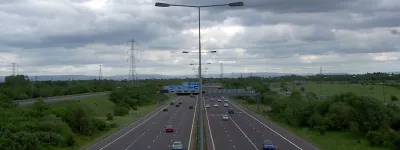In practice, this meant clearing a large area of central Birkenhead — including more than 170 homes, 90 shops, 23 factories and 14 pubs — and replacing it with vast open areas of tarmac and two kilometres of new elevated and tunnelled roads. The construction works lasted two years and four months, including the complete renovation of several railway tunnels underneath, with the computer controlled queueing system set up in a separate contract running for a further year. The scheme was opened to traffic in July 1969.
It was quite simple: traffic was funnelled into one of two marshalling areas which both led to the toll plaza. Each marshalling area was split into lanes. There was an overhead signal gantry running across the width of both marshalling areas at both the entrance and exit point of every lane, capable of showing a red cross or a white arrow.
On approaching, the motorist could take any lane showing a white arrow at the entrance and join the queue in that lane. The exit from all lanes was blocked by red crosses. The computer system would then allow a small number of lanes to proceed by showing them a white arrow, and at the same time block the entrance to those lanes with a red cross. Once a lane was empty it was allowed to fill up again from the back and other lanes were allowed to proceed to the tolls.
There was an inherent flaw with this scheme, which was that any regular user would quickly realise that the lanes were released in a sequence and would learn to join whichever lane was next to be released. The less scrupulous could always simply join an open lane and move across into one being released.
It didn't really matter; the system was installed in 1970 but never really worked properly. The computer system failed at its job quite miserably, and it was rapidly becoming clear that the new Kingsway tunnel to the north was clearing many of the Queensway's problems. By the time the queuing system was built and active, the epic congestion it was designed for had gone.
Liverpool dreams
At the other end of the tunnel, Liverpool had fewer problems to solve. With the congestion generated by the toll booths moved to the other side of the Mersey, its only concern was to get traffic flowing smoothly in and out of the tunnel mouth. By the late 1960s the city already had well-developed plans for an urban motorway scheme (the Liverpool Inner Motorway is detailed in another article) and the tunnel mouth had to connect to this.
Picture credits
- Photograph of Birkenhead traffic congestion taken from the 'Birkenhead Mersey Tunnel Approaches Scheme 1969' opening booklet.
- Engineer's sketch of signalling system taken from an original pen sketch in the consultants' design documents held at the National Archives, and recoloured from black and white.
- Photograph of Churchill Way flyovers by Bryn Buck and used with permission.
- Plan of Liverpool tunnel mouth redevelopment taken from an original held at the National Archives.
